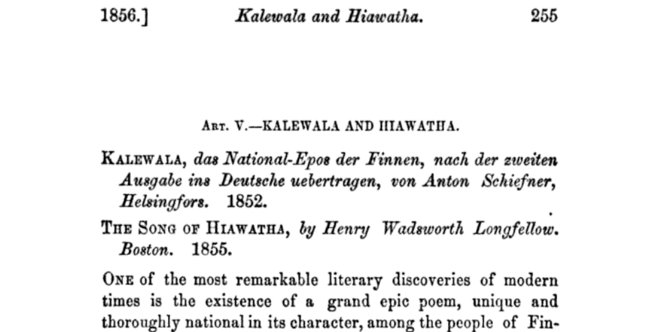Thomas C. Porter and the first translation in America 1855
The first translated excerpt of the Kalevala that was published in America was connected with a well-known dispute about the authenticity and influences of the epic The Song of Hiawatha by Henry Wadsworth Longfellow. Ernest John Moyne (previously Möykkynen) has explored the beginning of the dispute in his article, which was published in 1949.
W. Longfellow (1807–1882) was a famous American poet, who heard about the Finnish people and culture for the first time when he visited Sweden in 1835, a short while before the Kalevala was published. When he had learned about Finnish poetry, he also followed the phases of the Kalevala with great interest. In 1854 Longfellow read the recent German translation of the Kalevala by Anton Schiefner and, according to Moyne, this inspired Longfellow to write the “Indians’ epic”, something that he had planned to do for a very long time. Schiefner’s German translation inspired Longfellow when it comes to the topic, format and meter of The Song of Hiawatha.
Thomas Conrad Porter (1822–1901), a professor of chemistry, zoology and botany at the Franklin & Marshall College, discovered the similarities between the Kalevala and the Hiawatha when he also happened to read the translation by Schiefner. Moyne writes that, when Porter was reading the Kalevala in German, he was amazed to realise that the recently published The Song of Hiawatha and the Kalevala had much more in common than the poetic meter. According to Porter, Longfellow had also taken some of the most influential parts of the plot from the Kalevala.
Porter wrote an article about his findings in the magazine Washington National Intelligencer in November 1855. Proving his aggravating claims, he added his own translation of the first poem of the Kalevala to the article. A while later he published another piece on the subject in the New York Tribune and, furthermore, in April 1856, an extended essay Kalewala and Hiawatha in the academic journal The Mercersburg Quarterly Review.
”[Porter] strongly believed that taking the format, the feeling and some of the occurrences from the Finnish epic and using these in the Indian-Edda made The Song of Hiawatha into an adaptation and not the original masterpiece, which is was regarded as in America. Although T. C. Porter’s accusation toward Longfellow are not completely defendable, his writings about the Kalevala and Hiawatha are not only important because they revealed that Longfellow used some of the Finnish epic tale, but also because they contained the first printed English translations of the Kalevala in America”, summarises Ernest John Moyne.
Ernest John Moyne: “Kalevalan käännökset Amerikassa” – Kalevalaseuran vuosikirja 29. Helsinki: WSOY. 1949.
Thomas C. Porter: “Kalewala and Hiawatha” – The Mercersburg Quarterly Review vol VIII, 1856. Franklin and Marshall College.
Two Porters
There are two professors named Porter, not related, who are connected to the Kalevala translations in English.
